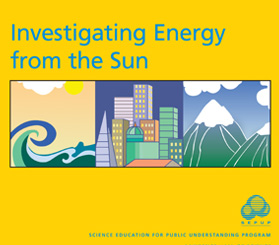Investigating Energy from the Sun – Module Issues in the News for Students

News
Scroll down to read summaries of recent news related to energy.
UV Radiation Disinfects Water
Water used in food processing must be disinfected in order to prevent illness. Usually this is done with ultraviolet (UV) radiation because it kills disease-causing molds, viruses and bacteria. Because UV radiation must be very close (within one inch) to the microbe to kill it, it has been expensive and time-consuming to use UV to disinfect water. In the past, water was pumped through long, narrow tubes with lots of UV lights.
Researchers at Georgia Institute of Technology have developed a pump that works much better. A small cylinder rotates inside of a larger stationary cylinder that has UV lamps on it. The water circulates between the two cylinders. This creates small vortexes, or whirlpools, which allow UV radiation to reach more water particles. Fewer UV lights are needed than with this method. This saves energy and reduces costs. Preliminary tests also show that the pump kills 200% more disease-causing organisms.
Researchers are looking into other applications of this technology. It may be used to disinfect swimming pool water and pasteurize fruit juice.
A Gene that Causes Skin Cancer?
A gene has been identified that causes at least some melanomas. Melanoma is the most deadly form of skin cancer. Usually related to sun exposure, melanoma sometimes appears on parts of the body that are never exposed to the sun.
Suzie Chen, an associate professor at Rutgers University, New Jersey, has discovered a gene that may be responsible. This gene normally helps with brain functions. “It is only in a melanocyte skin cell when the expression of this particular gene is turned on that it leads to the development of melanoma,” said Chen. “While in the brain, where it is expressed normally, its functions are associated with learning and memory.”
Cases of melanoma have doubled in the last 20 years. Early detection is the most important factor in successfully treating the disease. Researchers hope that by identifying this gene, more effective treatments can be developed.

